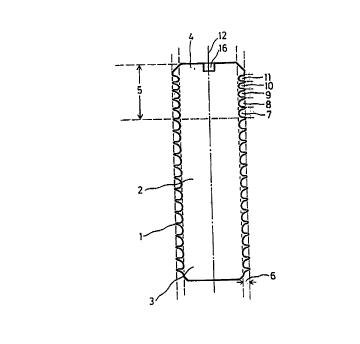Some of the information on this Web page has been provided by external sources. The Government of Canada is not responsible for the accuracy, reliability or currency of the information supplied by external sources. Users wishing to rely upon this information should consult directly with the source of the information. Content provided by external sources is not subject to official languages, privacy and accessibility requirements.
Any discrepancies in the text and image of the Claims and Abstract are due to differing posting times. Text of the Claims and Abstract are posted:
| (12) Patent: | (11) CA 2088102 |
|---|---|
| (54) English Title: | FASTENING ELEMENT |
| (54) French Title: | ELEMENT DE FIXATION |
| Status: | Expired |
| (51) International Patent Classification (IPC): |
|
|---|---|
| (72) Inventors : |
|
| (73) Owners : |
|
| (71) Applicants : |
|
| (74) Agent: | BORDEN LADNER GERVAIS LLP |
| (74) Associate agent: | |
| (45) Issued: | 1999-01-12 |
| (22) Filed Date: | 1993-01-26 |
| (41) Open to Public Inspection: | 1994-07-27 |
| Examination requested: | 1994-11-04 |
| Availability of licence: | N/A |
| (25) Language of filing: | English |
| Patent Cooperation Treaty (PCT): | No |
|---|
| (30) Application Priority Data: | None |
|---|
The fastener, which is especially adapted for bones,
consists of a shaft (2) bearing a thread (1) with variable pitch,
a front end (3) and a rear end (4).
The thread (1) is present over the entire area of the shaft
(2), and in the area of the rear end (4) is characterized by a
smaller pitch than in the area of the front end (3).
Thanks to the diminishing pitch of the thread (1) in the
proximal direction, a locally differentiated intraosseous
pressure generation takes place. In accord with the well-known
Wolff's Law, this leads to a controlled bone growth along the
loading axis and thus an improvement in the stability of the
implanted fastener.
Fixation, spécialement adaptée pour les os, constituée d'une tige (2) présentant un filetage (1) à pas variable, une extrémité avant (3) et une extrémité arrière (4). Le filetage (1) est présent sur toute la surface de la tige (2), ainsi que dans la zone de l'extrémité arrière (4) où son pas est plus petit que dans la zone de l'extrémité avant (3). Grâce à cette progression descendante du pas du filetage (1) en direction proximale, une pression intra-osseuse différenciée localement est exercée. Conformément à la loi de Wolff bien connue, cela entraîne une croissance contrôlée de l'os le long de l'axe de chargement et, par conséquent, une amélioration de la stabilité de la fixation implantée.
Note: Claims are shown in the official language in which they were submitted.
Note: Descriptions are shown in the official language in which they were submitted.

For a clearer understanding of the status of the application/patent presented on this page, the site Disclaimer , as well as the definitions for Patent , Administrative Status , Maintenance Fee and Payment History should be consulted.
| Title | Date |
|---|---|
| Forecasted Issue Date | 1999-01-12 |
| (22) Filed | 1993-01-26 |
| (41) Open to Public Inspection | 1994-07-27 |
| Examination Requested | 1994-11-04 |
| (45) Issued | 1999-01-12 |
| Expired | 2013-01-28 |
There is no abandonment history.
| Fee Type | Anniversary Year | Due Date | Amount Paid | Paid Date |
|---|---|---|---|---|
| Application Fee | $0.00 | 1993-01-26 | ||
| Registration of a document - section 124 | $0.00 | 1993-07-27 | ||
| Maintenance Fee - Application - New Act | 2 | 1995-01-26 | $100.00 | 1995-01-09 |
| Maintenance Fee - Application - New Act | 3 | 1996-01-26 | $100.00 | 1996-01-17 |
| Maintenance Fee - Application - New Act | 4 | 1997-01-27 | $100.00 | 1997-01-16 |
| Maintenance Fee - Application - New Act | 5 | 1998-01-26 | $150.00 | 1998-01-07 |
| Final Fee | $300.00 | 1998-08-18 | ||
| Maintenance Fee - Patent - New Act | 6 | 1999-01-26 | $150.00 | 1999-01-13 |
| Maintenance Fee - Patent - New Act | 7 | 2000-01-26 | $150.00 | 2000-01-04 |
| Maintenance Fee - Patent - New Act | 8 | 2001-01-26 | $150.00 | 2001-01-03 |
| Maintenance Fee - Patent - New Act | 9 | 2002-01-28 | $150.00 | 2001-12-19 |
| Maintenance Fee - Patent - New Act | 10 | 2003-01-27 | $200.00 | 2002-12-18 |
| Maintenance Fee - Patent - New Act | 11 | 2004-01-26 | $200.00 | 2003-12-17 |
| Maintenance Fee - Patent - New Act | 12 | 2005-01-26 | $250.00 | 2005-01-05 |
| Maintenance Fee - Patent - New Act | 13 | 2006-01-26 | $250.00 | 2005-12-22 |
| Maintenance Fee - Patent - New Act | 14 | 2007-01-26 | $250.00 | 2007-01-12 |
| Maintenance Fee - Patent - New Act | 15 | 2008-01-28 | $450.00 | 2007-12-31 |
| Maintenance Fee - Patent - New Act | 16 | 2009-01-26 | $450.00 | 2008-12-15 |
| Registration of a document - section 124 | $100.00 | 2009-03-13 | ||
| Maintenance Fee - Patent - New Act | 17 | 2010-01-26 | $450.00 | 2009-12-16 |
| Maintenance Fee - Patent - New Act | 18 | 2011-01-26 | $450.00 | 2010-12-17 |
| Maintenance Fee - Patent - New Act | 19 | 2012-01-26 | $450.00 | 2012-01-25 |
Note: Records showing the ownership history in alphabetical order.
| Current Owners on Record |
|---|
| SYNTHES USA, LLC |
| Past Owners on Record |
|---|
| MATHYS, ROBERT |
| SYNTHES (U.S.A.) |